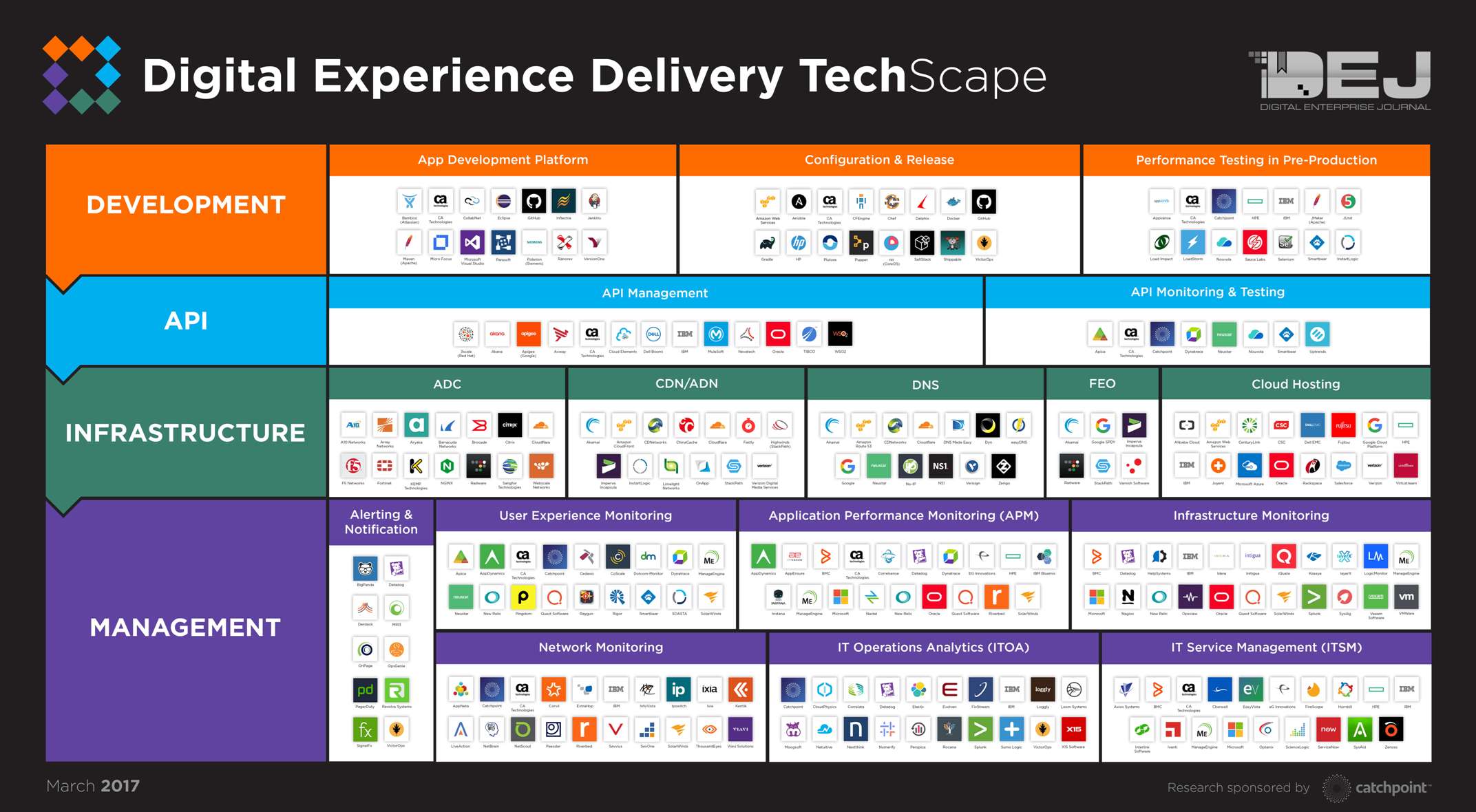In 2008, I published a study on web performance management titled “Customers Are Won or Lost in One Second”. One of the key findings of the study was that a one second delay in response times can significantly impact business metrics such as revenue, conversions and page views. From the technology perspective, the study was mostly focused on delivery (CDN, load balancing, front end optimization) and monitoring (synthetic and real-user) technologies. DEJ recently completed a comprehensive research on this matter and found that over the last nine years many things have significantly changed in this market. These changes can be grouped into 3 major categories: 1) digital transformation; 2) new definition of user experience; 3) new technology landscape.
DEJ’s 2016 Digital Transformation research shows that the key drivers for becoming a digital business are: 1) using technology as a source of competitive advantage; 2) adjusting to changes in customer demands for experience and engagement. Our recent research also shows that the process for evaluating the quality of user experience goes well beyond traditional metrics, such as availability and page load times. Lastly, trends such as new application designs and changes in development and pre-deployment practices, user requests to engage via different channels and devices, and the need for integration and advanced analytics created a new technology landscape. All of these trends forced the change from what used to be Web Performance Management to a more complex, business centric and innovation driven market – Digital Experience Delivery (DED).
The key findings of DEJ’s 2017 DED research can be summarized in 10 major categories:
1 – Delivery chain is becoming more complex and requires a diverse set of tools to be managed. DEJ’s DED TechScape includes 186 technology vendors grouped into 17 categories that all address the key aspects of digital experience. This shows that organizations should not be looking for a single solution for their management needs, but should find the right combination of tools that fits their goals the best. Also, DEJ’s research shows that organizations, on average, have 47% visibility into the entire delivery chain – from development and pre-production to the user’s interaction with the application. In order to ensure optimal digital experience, organizations need to eliminate these blind spots and ensure that their DED technologies work in sync.
2 – Definition of user experience is changing. Even though traditional KPIs, such as availability, page load times and even usage metrics, are still broadly used to evaluate user experience, organizations looking to create a true digital experience are increasingly incorporating three new areas in their user experience management strategies: 1) content delivery; 2) integration; 3) personalization.
3 – DED addresses key goals of digital transformation. The core value proposition of DED technologies is perfectly aligned with the top two drivers for digital transformation (as shown in the chart above). Digital transformation is changing the way organizations think about, leverage and purchase technologies, and the fact that DED is one of the key enablers for this process represents a major opportunity for technology vendors.
4 – From the management perspective, analytics have become a key differentiator. 82% of organizations in DEJ’s recent research reported that the amount of IT performance data collected increased over the last 12 months. However, only 38% of them reported significant performance improvements in key IT management areas. This shows that putting monitoring data in the right context is critical and, from the management perspective, DED is becoming data management and analytics play.
5 – APIs and integration are critical enablers for creating digital experience. DEJ’s research shows that companies who are leading in digital transformation are nearly 3 times more likely to adopt an API management strategy, as compared to their peers. The research also shows an 81% increase in the number of organizations that are looking to monitor performance of APIs since 2011. Adoption and management of APIs allows organizations to make a transition from traditional websites into customer engagement platforms and, therefore, create a true digital experience.
6 – TechScape categories are not homogenous. DEJ’s DED TechScape illustrates how different technologies come together for managing digital performance. However, it should be noted that even technology solutions that fall into the same category are not created equal and some providers of these solutions rarely or never compete against each other. When evaluating solutions from each of the categories, organizations should conduct a situational analysis to determine what solution is the best fit for THEM – based on their specific use case, type of technology environment that is being managed, goals that they are trying to achieve, etc.
7 – There is no alternative for a proactive management approach. DEJ’s research shows that organizations that are taking a proactive management approach are experiencing , on average, 71% service availability improvements. The ability to identify and prevent performance issues before users are impacted is one of the key prerequisites for optimal digital experience and should be a core part of DED strategies.
8- It is difficult to manage new environments with old tools. Organizations are reporting, on average, only a 24% decrease in page load times since 2008. This is not to say that these organizations were not putting effort in optimizing digital performance or that there was not enough innovation in the market around the management tools. This shows that delivering optimal digital experience is becoming more difficult due to new management challenges, such as different application designs, new functionalities and types of content, etc.
9 – User expectations for the quality of digital experience are changing. 61% of organizations in DEJ’s research reported that user expectations for performance increased over the last 12 months.Additionally, 56% reported that their customers are looking to engage through different channels, which is creating management challenges. Therefore, delivering a true digital experience includes different devices, platforms and functionalities while users increasingly are expecting higher levels of performance.
10 – The cost of non acting is very high. DEJ’s research shows that 48% of organizations are designing digital experiences to create new revenue streams. However, the research also shows that organizations are losing, on average, $72,000 per minute of service outages, while 48% of organizations reported that, on average, they spend more than 60 minutes on repairing performance issues per incident. Interestingly, the business impact becomes ever more significant when we look at how issues with digital experience impact the revenues. Even though the revenue impact of performance slowdowns, per incident, is lower than with the impact of availability issues, performance problems are nearly 10 times more frequent as compared to service outages. As a result, organizations are losing nearly twice as much in revenues due to issues with digital experience as compared to service outages.
The Digital Experience Delivery technology ecosystem is rapidly changing with a lot of innovation being introduced, especially in Development and API Management categories. That is further driving the need for Management vendors to introduce new capabilities and adjust to new technology environments.














